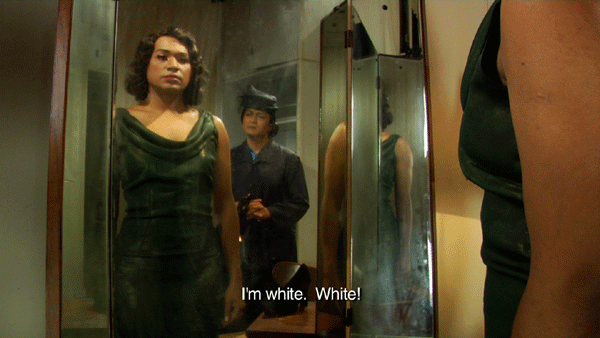Life of Imitation
double channel video installation
13:00 mins loop
2009
 LIFE OF IMITATION
LIFE OF IMITATION
double channel video installation
13:00 mins loop
2009
Originally commissioned for the 53rd Venice Biennale for the artist’s solo exhibitioin Life of Imitation at the Singapore Pavilion, this work is inspired by a scene from the classic Hollywood melodrama by Douglas Sirk, Imitation of Life (1959) where a black mother meets her mixed-race daughter who has been running away from her true ‘identity’.
This version features 3 male actors from the 3 main ethnic groups in Singapore (Chinese, Malay and Indian) taking turns to play the black mother and her ‘white’ daughter. The identity of the actor for each role constantly changes with each shot.
“Sirk’s 1959 film Imitation of Life provides the basis for his Life of Imitation (2009), which reworks the pivotal scene in which the character Sarah Jane, who has abandoned her mixed-race background to pass as white, is visited for the last time by her black mother. The tearful reunion/farewell is a typically heart-wrenching Sirk moment, with Sarah Jane at first rejecting her mother and then holding her tight and weeping as her feelings take over. Ming replaces Sarah Jane and her mother with Chinese, Malay and Indian male actors from Singapore (representing the dominant racial groups in the country), who change from shot to shot so that the interpersonal dynamics continually shift, blurring what are often rigid delineations in real life.
The scene takes place in a hotel room, in the town where Sarah Jane is working as a chorus girl, under the assumed name of ‘Linda’. Despite her protestations to the contrary, she can’t pretend to her mother that she is the white woman she has been passing herself off to be. Facing a mirror (a recurrent motif in melodrama), she proclaims her whiteness, but she can’t quite look at herself. In Ming’s version, none of the men are white either (nor black for that matter) and furthermore, are in drag: ‘passing’ as women, imitating a gender not prescribed as their own. Yet, as Judith Butler has argued, we can think of drag not as an imperfect copy, but rather a performance that ‘implies that all gendering is a kind of impersonation and approximation. If this is true, it seems, there is no original or primary gender that drag imitates, but gender is a kind of imitation for which there is no original’. ”
Russell Storer, Repeat After Me (Exhibition catalogue)
Cast: Sebastian Tan, Moe Kasim, Alle Majeed
Music composed by Heathcliff Blair